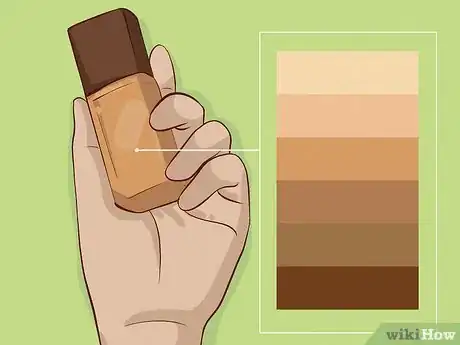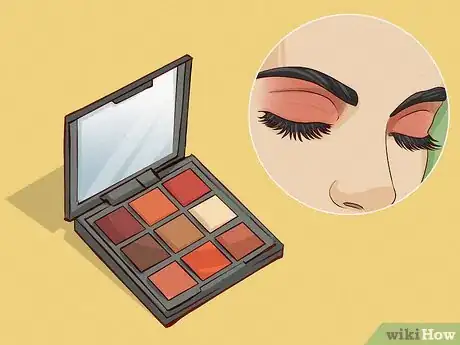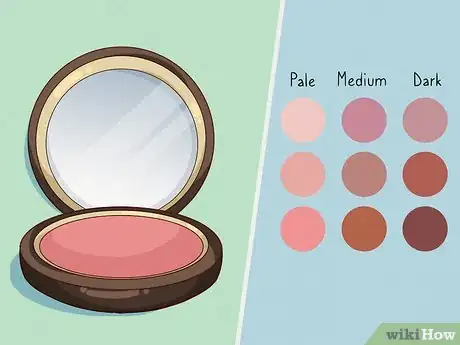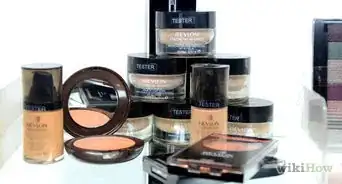X
wikiHow is a “wiki,” similar to Wikipedia, which means that many of our articles are co-written by multiple authors. To create this article, 15 people, some anonymous, worked to edit and improve it over time.
This article has been viewed 25,038 times.
Learn more...
Do you find makeup shops confusing? Follow these steps to make things a little clearer. Who said choosing makeup has to be hard?
Steps
-
1Base your foundation on your skin type. Skin can be normal, oily, dry, or mixed.
- Normal skin works well with mostly any type of foundation.
- Oily skin usually does best with powder foundations.
- Dry skin can benefit from tinted moisturizers.
- For mixed skin, liquid, cream, or mousse foundations are usually a safe bet.
-
2Choose your foundation shade. For this you'll need to test product in person. Using tester products, apply a small amount of foundation to the back of your arm, which will usually be a skin shade close to that of your face. Also apply dabs of foundations a shade lighter and darker than the one you think will be your match. Once they've dried, see which shade matches closest to your skin. If you're torn between shades, err to the lighter shade.Advertisement
-
3Pick your eyeliner. There are a few types of eyeliner you can choose from.
- Pencils are easiest to use and blend well with eyeshadows.
- Powder gives a softer look, and the size and shape of the line is as easy to control as changing your brush.
- If you're looking for a smooth, sharp, or dramatic look (and you have a steady hand) liquid eyeliner could be the right choice.
-
4Decide your eyeshadows. Shadows can be based on eye color or skin shade.
- Brown eyes match well with purples, blues, and metal colors such as copper, silver, and gold.
- For hazel eyes, dark purples, yellows, and greens work well, but not blues.
- For blue eyes, try cool colors, dark browns, or oranges.
- For green eyes, you may find smoky grays and charcoals, plum, violet, beige, or tan to be a good fit.
- When it comes to pale skin, avoiding darker and smokier colors is best; go with light earth tones.
- Vibrant colors are best for darker skin tones, but be sure to avoid ashy and white shades.
-
5Figure out your best blush.
- Pale skin is easily complemented by light pinks and peaches
- Medium skin suggests using rosy pinks and darker peach shades
- For dark skin rose shades and deep oranges are great choices.
-
6Get your lips just right. The simplest method of choosing a lip color is going with a shade a couple shades darker than your natural lip shade.
- If you want to go red, remember that for pink skin tones cherry reds fit well, for olive skin tones firetruck reds work, and for darker skin tones deep reds are the way to go.
- If you want more options, pale skin pairs well with apricots, pinks, and creams; medium tones can wear roses and berries well; dark skin can be beautifully accented with dark browns or deep or vibrant purples.
Advertisement
Community Q&A
-
QuestionHow do I choose the right brands?
 HumanBeingTop AnswererThe right brand is the brand you like best! Consider cost, ease of application, the look of the product, any brand loyalty you have to suppliers or designers and, of course, how good the product makes you look. You don't have to stick to one brand; you can use foundation from one maker and eye shadow from another, for example.
HumanBeingTop AnswererThe right brand is the brand you like best! Consider cost, ease of application, the look of the product, any brand loyalty you have to suppliers or designers and, of course, how good the product makes you look. You don't have to stick to one brand; you can use foundation from one maker and eye shadow from another, for example.
Advertisement
About This Article
Advertisement




























































